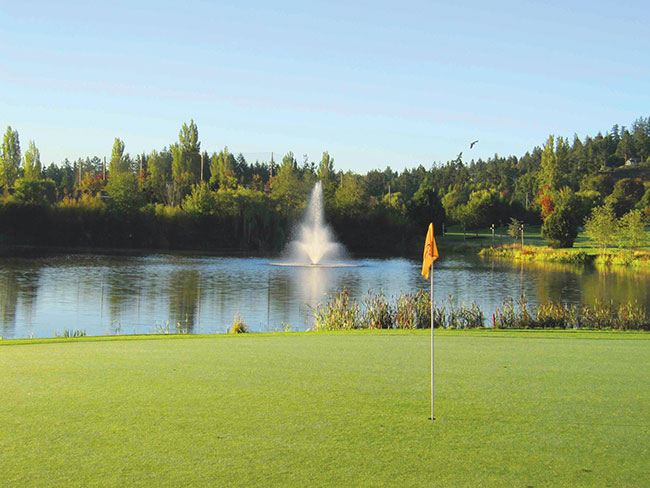
Features
Eco-Friendly Practices
Pond restoration can present different options to managers
Choice between biological and manual removal depends on several factors
June 26, 2023 By Julia Webber
 Pond at Cordova Bay Golf Course in Victoria, B.C.
Photo credit: Julia Webber
Pond at Cordova Bay Golf Course in Victoria, B.C.
Photo credit: Julia Webber To dig or not to dig. This is always a challenging question for our customers when faced with an aging pond. Let’s look at the strengths and shortcomings of different pond restoration methods so you know what to expect. There are essentially two main restoration methods for an older pond that has started to fill in: biological removal and manual removal. Which will work best depends on the pond’s condition, setup and your timeline.
How does a pond that started out as a clean-dug hole end up as a pond that has filled in and is unsightly? Essentially, everything that has been in the pond over the years or blown into the pond has stayed there and is now very slowly breaking down at the bottom. This breakdown, especially without oxygen, can be substantially slower than it is accumulating, so the pond becomes shallower.
To add to the problem, the thicker this layer of dead weeds and debris on the bottom becomes, the slower it can break down, as oxygen only reaches the very top. Shallow ponds with good organic layers at the bottom will cause plant life to thrive and multiply. This means you have even more plants that will grow and then die off in the fall and sink to the bottom.
On and on it goes until you have a puddle in the middle of a swamp! I bring this up so that we realize this is where all ponds are headed unless we intervene. This is the natural progression. We can start restoring a pond long before it reaches the point where it really is not a pond anymore if we are aware of this progression.
Now that we know that ponds are filled in by organic matter – what you would call compost in a garden – we can look at options for removing it. The first option for restoring a pond would be biological removal. This process uses aeration and probiotics to break down the organics in the pond at a much more rapid rate than would naturally occur. Pond probiotics, like the ones we use for our digestive system, are beneficial bacteria that are targeted to a specific task. In this case we use aerobic (oxygen-loving) bacteria that are safe for the environment, humans, pets and wildlife. These bacteria use the organic layer in your pond as a food source and redirect it into the food chain instead of it fertilizing weed and algae growth.

Biological pond restoration allows you to restore your pond in a way that is safe and natural while not disturbing the wildlife. This can save long hours of capturing fish and other wildlife as well as finding ways to keep them while the pond is being cleaned. This is also easy for property owners to apply themselves.
It is, however, a slow process, often taking at least two to three years to see results as our colder climate makes the application season so limited. As this process does take time, it is not always the best fit for ponds that have become very shallow and are hard to access, but it can be a great fit for ponds that are earlier in the process to prevent them from getting to this point.
The other place that this biological process is very helpful for are ponds that are connected to a river, also called inline ponds. Because of their integration into a water course and possible proximity to sensitive ecosystems, this type of pond generally cannot use manual removal methods. This is because there is a high likelihood of organic material washing downstream, causing harm to sensitive habitat, smothering eggs and clogging streamflow. In this case, by using the slower biological method, the pond can still be maintained while protecting the ecosystems and avoiding problems with local conservation agencies.
The other method of removal is one we are more familiar with: manual removal. This involves bringing in equipment to clean out the pond – generally excavators and dump trucks. There are new techniques now though that use suction dredging to pump debris off the bottom without having to drain the pond. Both methods involve large equipment and will mean hauling away the organic material. As such, they can be very costly and may involve getting permits. The process can be done relatively quickly and will clear the pond of not only organic material, but likely also many weeds.
Julia Webber is the president of Fish Farm Supply Co. Inc., which has been serving the lake and pond industry since 1989.
Print this page